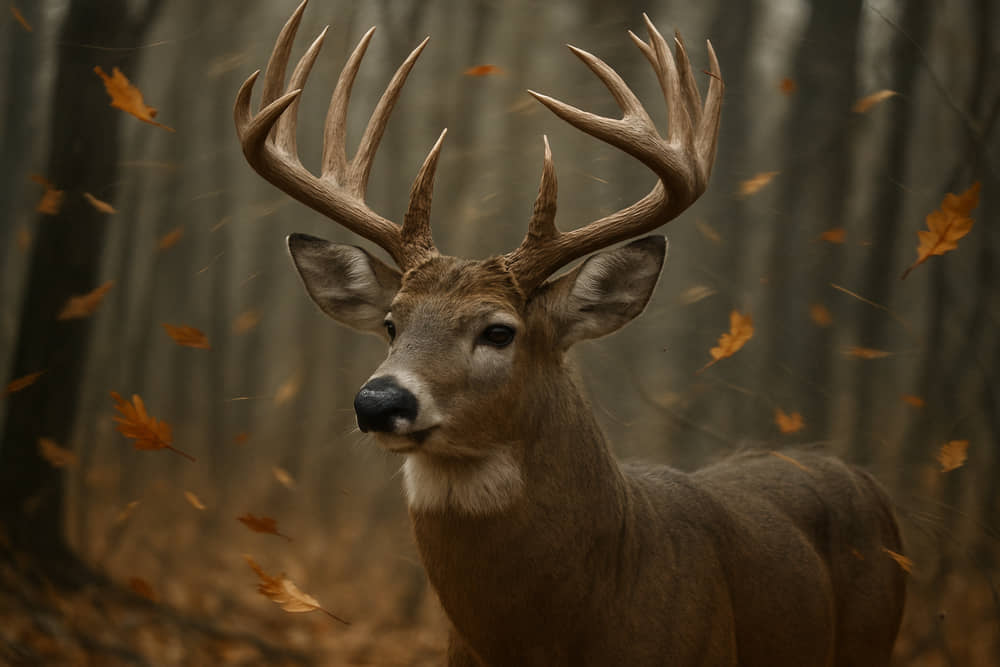Many hunters invest heavily in rifles, bows, camouflage, and high-tech gear, but they often overlook one invisible factor that determines success or failure: the wind. Deer have an extraordinary sense of smell—up to 40 times stronger than that of a hunting dog. If they catch even the faintest trace of human scent carried by the wind, they will vanish instantly, leaving hunters frustrated and empty-handed.
Countless hunters have shared stories of having a trophy buck within range, only to watch it disappear because the wind exposed their scent. No matter how accurate your rifle is or how sharp your broadhead may be, failing to understand wind direction can cost you the hunt. That’s why learning the right Deer Hunting Wind Direction Tips is critical for anyone who wants to improve their chances in the field.
In this guide, we’ll explore practical strategies for reading the wind, choosing the best stand locations, and staying undetected during deer hunts. These proven tips are simple to apply but can dramatically increase your success rate. Whether you’re new to deer hunting or a seasoned outdoorsman, mastering wind direction will give you a decisive edge this season.
Table of Contents
Why Wind Matters in Deer Hunting
If there’s one thing that separates successful hunters from frustrated ones, it’s the ability to understand how wind direction affects deer behavior. Deer rely heavily on their sense of smell to survive. In fact, biologists estimate that a deer’s nose is thousands of times more sensitive than the human nose, and even stronger than most hunting dogs. This heightened sense of smell allows deer to detect danger long before they see or hear it.
When you step into the woods, your body naturally carries scent—whether it’s from your skin, clothing, food, or even your truck ride to the hunting area. The wind becomes the delivery system that carries this scent directly to a deer’s nose. If the breeze is blowing from you toward the path a deer intends to travel, the hunt is over before it even begins.
That’s why wind direction is often called the “silent deal-breaker” in deer hunting. A poorly chosen stand location or careless approach can alert deer and ruin hours of preparation. Conversely, when hunters use the wind to their advantage, they can move through the woods more confidently, set up stands more effectively, and position themselves where deer least expect human presence.
Simply put, the wind can either betray you or protect you. By learning to “hunt the wind,” you reduce the chances of being detected and dramatically increase your odds of success. Understanding this invisible but powerful factor is the first step toward mastering deer hunting strategy.
How to Check and Read Wind Direction Before Hunting
Before stepping into the woods, one of the most important preparations a hunter can make is to check the wind direction. Many beginners overlook this step, but seasoned hunters know that failing to monitor the wind is one of the fastest ways to ruin a hunt. Fortunately, there are several practical methods to read the wind and stay ahead of a deer’s nose.
The simplest approach is to use wind check tools such as powder bottles, chalk dust, or even a pinch of milkweed fluff. By releasing these particles into the air, you can instantly see the direction and subtle shifts of the breeze. Unlike looking at tree branches or leaves, these lightweight indicators reveal even the smallest air currents that could betray your scent.
Technology also offers reliable support. Mobile apps like HuntStand, OnX Hunt, or Windy provide detailed wind forecasts, including changes by the hour. While these apps are excellent planning tools, it’s wise to double-check conditions once you’re in the field, since terrain can cause localized variations that apps may not capture.
Another tip is to test the wind multiple times throughout the hunt. Morning thermals often push air downhill, while afternoon warming causes air to rise. This means the wind direction you checked at sunrise may be completely different by midday. Experienced hunters always carry a quick-check tool in their pocket to stay aware of these changes.
By making wind checks a consistent habit—before you walk in, while you set up, and during the hunt—you’ll avoid surprises and keep your scent from traveling where deer are likely to be. It’s a small step, but one that can make a big difference in your overall success.
Choosing Stand and Blind Locations Based on Wind
Even the best stand setup is useless if the wind is not in your favor. When selecting a treestand or ground blind, you must always consider how your scent will travel once you’re in position. Deer are creatures of habit and often use the same bedding areas, food sources, and travel corridors. If your scent blows directly into these areas, you’ll be detected long before you ever see a deer.
The golden rule is simple: set up downwind of where you expect deer to appear. This means that the wind should blow from the deer toward you, carrying your scent away from their path. For example, if deer are likely to approach from the north, you should only hunt that spot when the wind is blowing from the north to the south.
Topography also plays a role. Valleys, ridges, and thick woods can create swirling winds that don’t behave as predicted. To reduce this risk, place stands in areas with more consistent airflow, such as open edges or gentle slopes. If hunting in terrain where winds are unpredictable, consider having multiple stand locations so you can adapt based on the day’s conditions.
Ground blinds require the same strategy. While blinds provide some scent containment, they are not foolproof. Always position a blind with the wind at your advantage and avoid setting up directly upwind of a trail or food plot.
By carefully aligning your stand or blind with the prevailing wind, you’ll drastically reduce the chances of alerting deer. Smart positioning, combined with scent control, allows you to remain undetected and maximize your hunting opportunities.
Read more: How Much Wind Is Too Much For Deer Hunting?
Movement and Stealth Strategies in Windy Conditions
Even if you’ve chosen the perfect stand location, the way you move through the woods can make or break your hunt. Deer rely on both scent and sound to detect danger, and the wind plays a big role in how both of these elements travel. Mastering stealthy movement with the wind in mind is a critical part of deer hunting success.
One effective strategy is to move crosswind rather than directly upwind or downwind. Moving crosswind keeps your scent from blowing straight toward potential deer trails while still giving you some control over how it disperses. This tactic is especially helpful when approaching your stand or stalking in areas where deer activity is high.
Windy conditions also help mask noise. Leaves, branches, and other natural elements make constant background sounds in strong winds, allowing hunters to move more freely without being detected. However, this doesn’t mean you should rush. Keep your steps slow, deliberate, and in sync with gusts of wind to blend into the environment.
Another key tactic is to use natural cover combined with wind direction. Position yourself so that the wind blows your scent into thick cover or open fields where deer are unlikely to travel. This reduces the chance of deer catching your scent trail while you move.
Finally, never forget to refresh your scent control routine before entering the woods. Even if the wind is in your favor, strong human odors from clothing, sweat, or food can betray you. Combine scent-free sprays, clean hunting gear, and wind-smart movement for the best results.
By mastering how you move in relation to the wind, you’ll stay undetected longer and increase your chances of getting close to that trophy buck.
Advanced Wind and Thermal Strategies
Once you’ve mastered the basics of wind direction, it’s time to take your deer hunting to the next level by understanding thermals—the natural rise and fall of air caused by temperature changes throughout the day. While many hunters only pay attention to the prevailing wind, thermals can dramatically influence how your scent travels, especially in hilly or mountainous terrain.
In the morning, as the air is cool, thermals typically flow downhill. This means your scent will drift toward lower elevations until the sun begins to warm the ground. By late afternoon, as the ground heats up, thermals reverse and begin to rise uphill, carrying your scent upward. Recognizing these daily shifts can help you decide where to set up and when to move.
Experienced hunters often plan their hunts around these thermal patterns. For example, setting up lower in the morning and higher in the evening aligns with natural airflow, keeping your scent away from deer travel routes. Ignoring thermals, on the other hand, can ruin an otherwise perfect setup.
Another advanced strategy is to combine terrain features with wind and thermal behavior. Ridges, valleys, and thick timber can create swirling air currents that confuse hunters but are obvious to deer. Scouting these areas on different days and times helps you learn how wind behaves in specific locations.
Finally, remember that deer themselves use the wind and thermals to their advantage. They often bed down where they can smell danger from below and see it from above. By anticipating how deer use the wind, you can position yourself in places where they least expect hunters to be.
Understanding thermals and advanced wind behavior takes practice, but once mastered, it gives you a huge advantage in staying undetected and harvesting more deer.
Conclusion
At the end of the day, deer hunting is as much about strategy as it is about skill and equipment. You can have the best rifle, sharpest broadheads, or the most advanced camouflage, but if you ignore the wind, you’re giving deer the advantage. Their incredible sense of smell makes wind direction the deciding factor between success and failure in the field.
By applying the Deer Hunting Wind Direction Tips we’ve covered—checking the wind consistently, setting stands downwind, moving strategically, and mastering thermals—you’ll reduce the chances of being detected and increase your opportunities to harvest a mature buck. These tactics may seem small, but together they create a powerful edge that separates seasoned hunters from those who go home empty-handed.
Remember, the wind is an invisible ally or enemy, depending on how you use it. The more you respect and adapt to it, the more consistent your results will become.
Now it’s your turn: Have you ever lost a chance at a deer because of the wind? What strategies do you use to beat a deer’s nose? Share your experience in the comments and help other hunters sharpen their skills this season.

